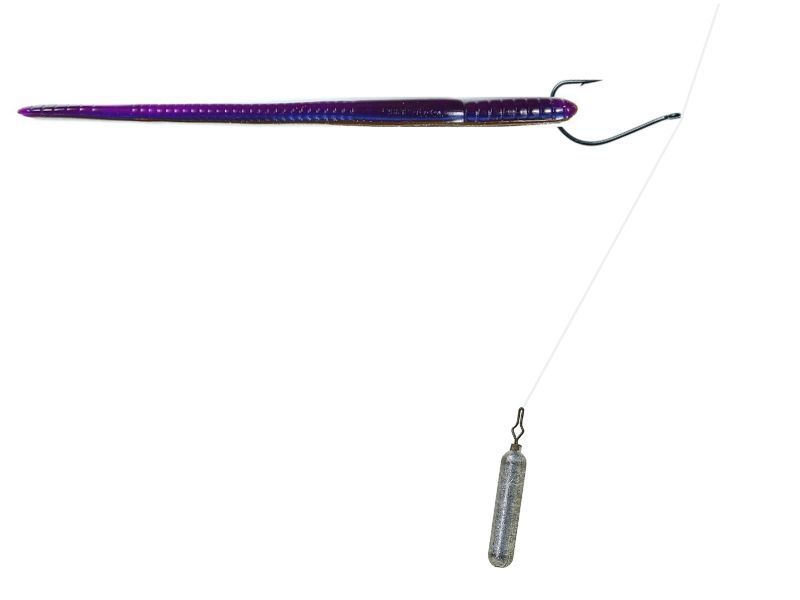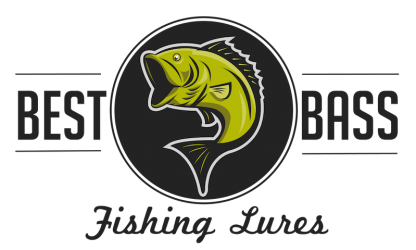
The drop shot rig is one of the most effective worm rigs for anglers battling a tough bite. It’s so effective that it has become the go-to technique for tournament anglers that need to put bass in the livewell. One of the best examples is Aaron Martens, who has found great success with the rig and has been helping popularize it since the 1990’s.
In a way it’s somewhat similar to the Carolina Rig, with the purpose being to keep the worm free floating just above the bottom. Although both rigs achieve a similar presentation, the weight is positioned differently. Instead of the weight being set on a leader before the worm, the weight is positioned after the worm. This gives the worm a different action, and the angler has full control of it.
The basic goal of a drop shot rig is to have the weight hit the bottom and leave the plastic worm suspended above it. The distance the worm is suspended off the bottom is predetermined by how long you make the drop shot leader. So let’s start there.
How To Rig A Drop Shot
You only need three things to rig a drop shot: a worm, a hook, and a weight. The hook is tied to the line with a palomar knot but without clipping the tagline off. At the end of the tagline is where you are going to tie the weight. So the length of the tagline is going to determine how far your worm suspends above the bottom.
You can really use any weight you think works best, but the most popular choices are either a teardrop weight or cylinder weight. A lot of anglers find that the cylinder weights work better when fishing weeded areas. Its slim shape allows it to easily slips in and out of vegetation. This leaves the teardrop weights the better choice for open water and/or rocky bottoms.
There are three main ways to rig the worm on a drop shot: wacky style, Texas style, and nose hook style. The nice thing is you can use just about any worm style or size with either one, but some are better for certain fishing scenarios. Let’s take a look at each worm rigging style.
Nose Hooked Drop Shot
The most popular way to rig a drop shot is with a nose hook. Drop shots are so commonly used for a finesse presentation, and the best way to do that is nose hooking the bait. It’s also the best choice for fishing open water and there is not a lot of cover to get hung up on.
Most of the time small shad baits like a Strike King Dream Shot are used with this style. The hook penetrates through the nose of the bait in a way that allows it to float perpendicular to the line. A great hook to use with this rig is an Owner Mosquito Light Hook, in either size 1 or 1/0.
Texas Rigged Drop Shot
This is the ideal choice when drop shotting areas with vegetation or other cover that you could get hung up on. Rigging the worm Texas style will allow you to fish it just about anywhere because the Texas Rig is the most weedless way to rig a worm.
The best way to rig it is with an offset shank hook. This will keep the worm nice and straight. While you can still finesse fish a Texas rigged drop shot, it’s going to take a heavier hookset to drive the hook home. Most anglers fish this rig with slightly heavier gear to for that reason.
Wacky Rigged Drop SHot
If the straight-bodied, horizontal presentation isn’t getting bites then there is always the Wacky Rig. This gives the bait a different presentation that has more action. It can also be rigged weedless if rigged with a hook that has a weedguard.
Wacky rigging is always an effective way to catch bass, with both finesse fishing and standard techniques. To wacky rig this you simply take a stickbait, like a Senko, and hook it right in the center of the worm so that both ends sag down equally on each side of the hook.
Drop Shotting For Bass
Most of the time a drop shot rig is used as a finesse fishing technique, using light gear, light weights, and small worms. But what most anglers don’t realize is you can catch bass rigging it with whatever you want. Some anglers will even use a one ounce weight and a creature bait when fishing this rig.
But whichever way you decide to rig it, the ways you work the rig are going to be the same. The idea is to cast the rig out and let it sink while always keeping full attention on the line. This is important because a lot of strikes happen when the bait is falling.
When the weight hits the bottom and is no longer pulling the worm downward it is going to stop abruptly. This causes the bait to go from quickly sinking to instantly stopped and suspending. This is another time to be on high alert because this sudden change in action can cause a reaction strike.
Working the Bottom
If there are no bites at this point then it’s time to work the rig. There are two ways to work a drop shot, you can either work the worm or work the weight. When you work the weight you are trying to bounce the weight up and down off the bottom.
This can be done with quick rod jerks to make the weight pop up and down, or by slowly raising the rod up and down. Whichever way you do it the worm is going to get pulled up and down, basically in the middle of a tug-of-war between the angler and the weight.
When you choose to work the worm you are taking more of a finesse approach. This is when you let the weight sit on the bottom and lightly shake the rod tip to make the worm dance. You do this for a bit then slowly drag the weight along the bottom and repeat. This is a fantastic method for fishing cold water.
Vertical Jigging
Another way to drop shot is by vertically jigging for bass directly under the boat. This can be great for targeting suspended schools or fish on the bottom near cover or structure you are aware of. But unless you see these targets through the water, you are going to need electronics.
When targeting these suspending bass using electronics, some call it video game fishing. Because essentially you are watching the screen as you work the rig. It’s actually pretty cool to be able to see your lure and how fish react to it right on the fish finder.
Fish finders are also great for locating submerged cover and structure. Trolling around those areas and dropping the drop shot right in from overhead works great. It’s hard to beat a drop shot when targeting bass directly under you and still have a good presentation.

